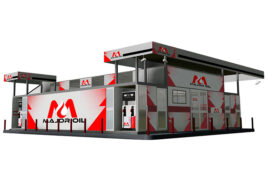Display cases hold and merchandise products effectively and offer customers a quick showing of the operator’s menu selections. The idea is to give Mr. Customer the opportunity to view the retailer’s fareand increase the likelihood of him making a purchase. Convenience retailers can choose from an overwhelming selection of equipment, but without the proper amount of research it’s tough to make an informed decision. Following are a few things to consider.
In response to operators’ desires to merchandise and display product better, equipment manufacturers have brought to market a wide variety of attractive display cases. It is not just a question of whether to display food, but how to do it most attractively. Just as the beauty of a picture frame can make a work of art more beautiful, an attractive display case can enhance the food held within. Displaying food and beverages effectively, of course, is a correlation to maximizing sales.
Display cases are either self-service or serviced units. Self-service models are used most frequently but serviced models can be found at deli stations serving any hot-ready items like fried chicken or barbecue. Serviced models require an aisle space to access the unit from the rear. These units typically measure 42″ to 51″ high, so employees can still see the customer over the top of the case. Serviced cases are generally available in one-foot increments generally starting with a 24″ long case. Some manufacturers make “endless” cases that can be customized to any length. Many of these same manufacturers can add customized angles to make integral corners or serpentine arrangements.
Self-service refrigerated cases are available as freestanding units or as doors to walk-in refrigerators. Freestanding cases come in a variety of styles and sizes. Some cases display product at counter height while others stand 6′ tall and higher. In all there is a dizzying array of functional case styles for different uses. Retailers must determine the specifics of how a case is to be used in relation to the capabilities of the unit.
Once the functional needs for the operation have been met, retailers can choose among an equally varied choice of colors, finishes and trim details.
Freestanding traditional door refrigerators have some uses but for ease of customer access and superior merchandising, open “air screen” units do the job well in c-stores. Air screen cases are typically built with oversized refrigeration systems. These systems maintain temperature and humidity while compensating for the open front exposed to store temperature. Even with the oversized systems, operators must control temperatures in the vicinity to ensure proper operating temperatures will be maintained. New health and sanitation regulations require units holding food to maintain temperatures inside the case at 41°F. There have been changes in National Sanitation Foundation (NSF) requirements recently which may impact the acceptability of some cases. Although these regulations do not apply to non-perishable beverages, retailers intending to have open food product in their cases should select a model with an NSF listing.
Other types of special refrigerated and non-refrigerated cases are made for bakery products. The refrigerated ones control humidity and reduce air flow to help keep refrigerated baked goods from drying out. Refrigerated bakery cases can almost always be mated with identical-looking ambient temperature units to display a full range of baked goods.
Other specialized hot display case types include rotisseries and pizza cabinets. Some rotisseries actually cook whole chickens or other items and some keep cooked items warm while turning on a spit. Pizza cabinets, some featuring turntables, hold several whole pizzas on shelves and generally come in the form of countertop units, while the rotisseries can be either countertop or full-height units.
Well-designed hot or cold display cases are ideal for many operations. But when merchandising prepared foods, retailers must have product in the cases even during slow periods. Don’t overestimate the need for display case spacebecause the case will need to be kept full.
No matter how much or what kind of product retailers wish to display, there is almost certainly a case made to meet the specific need; suppliers can help find the right equipment in terms of function and cost. The industry offers a wide range of equipment to choose from that will fit virtually any budget or aesthetic preference.




